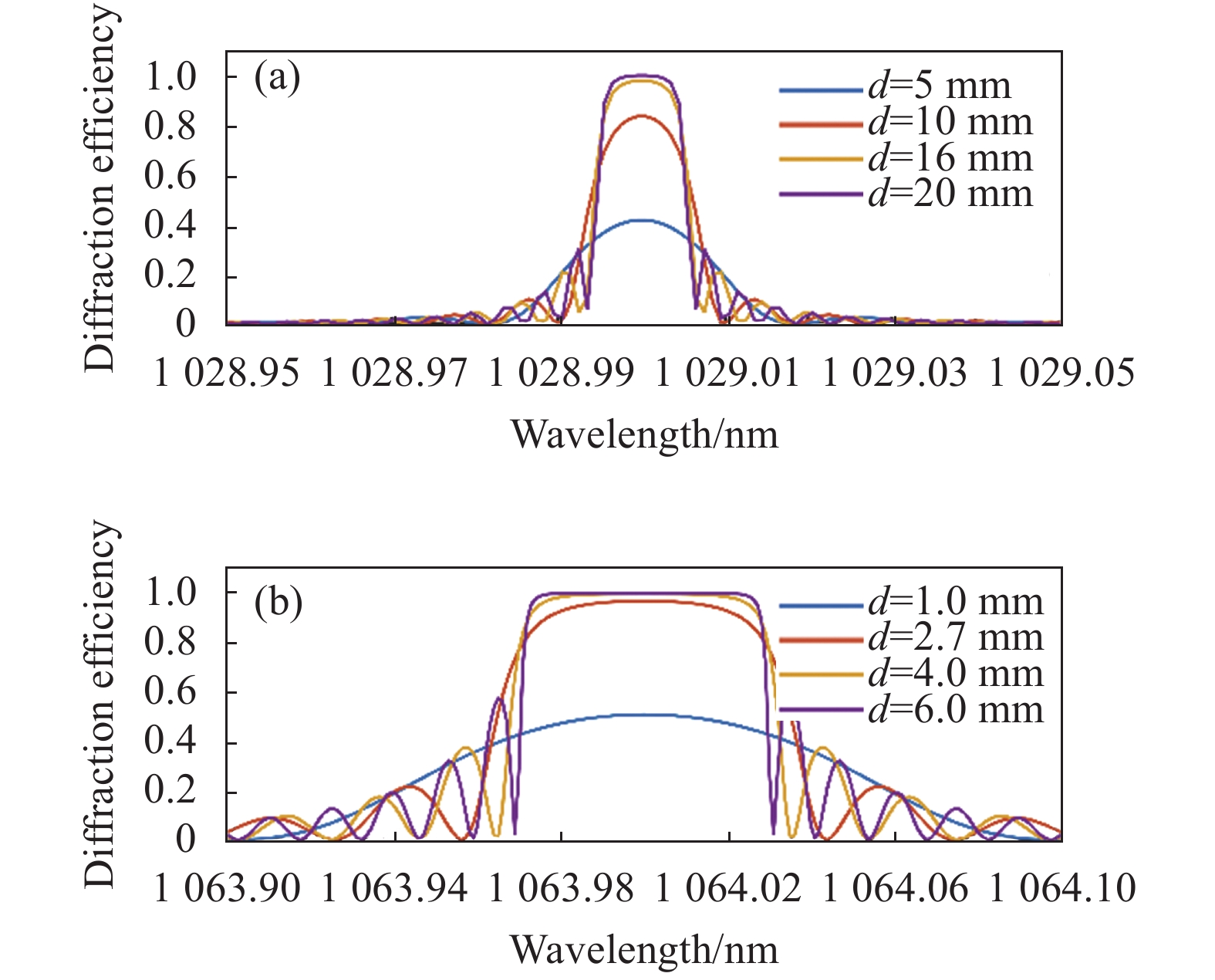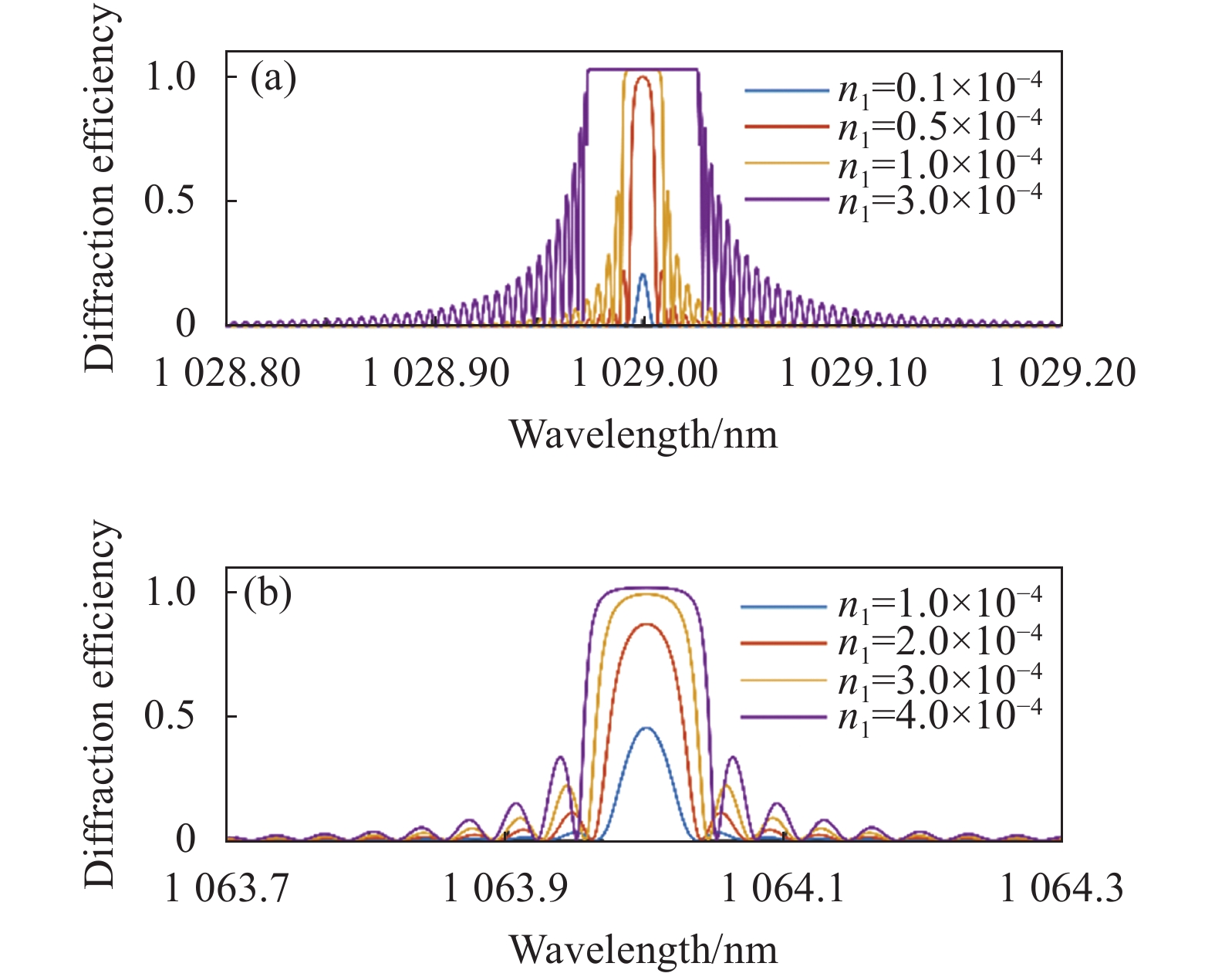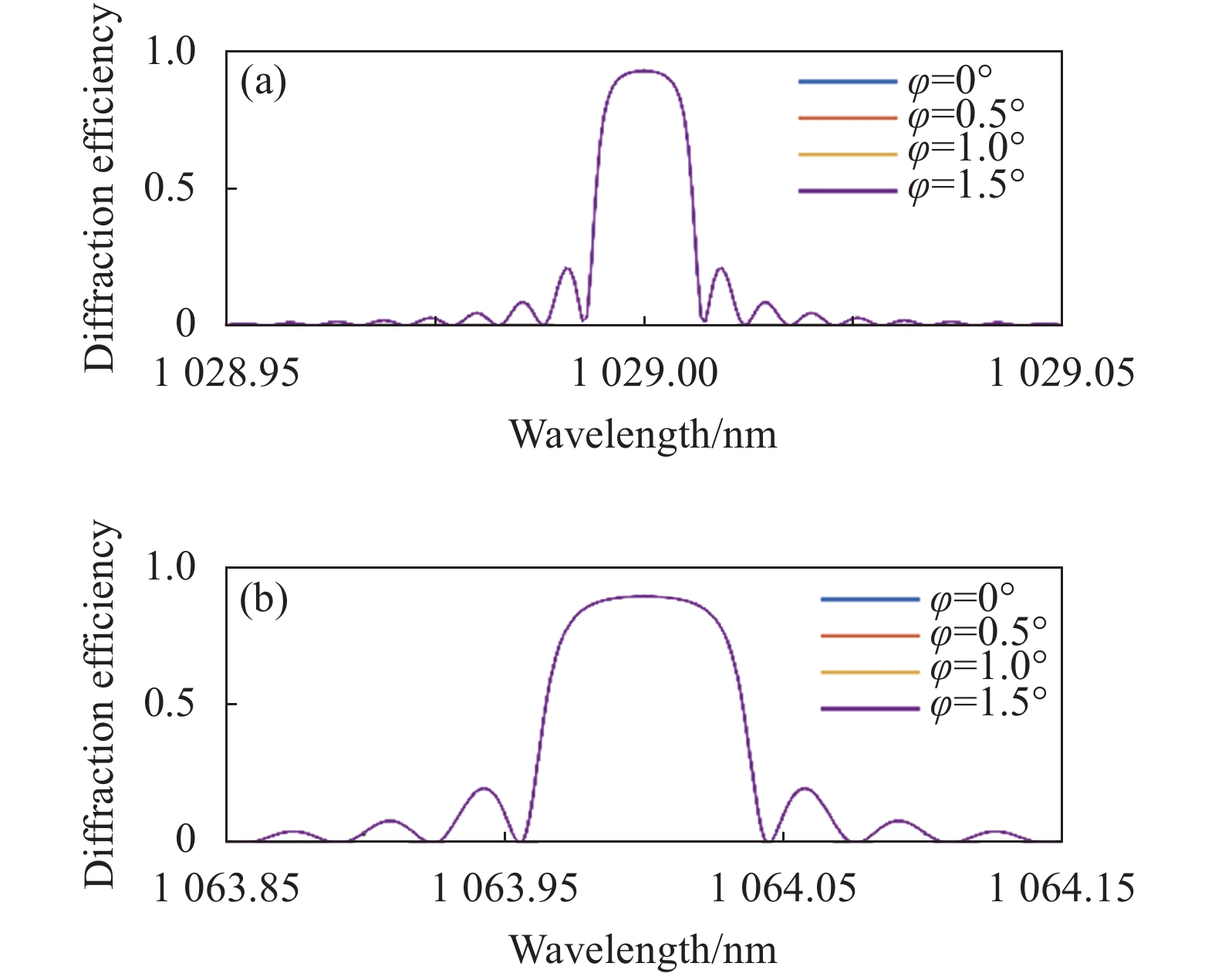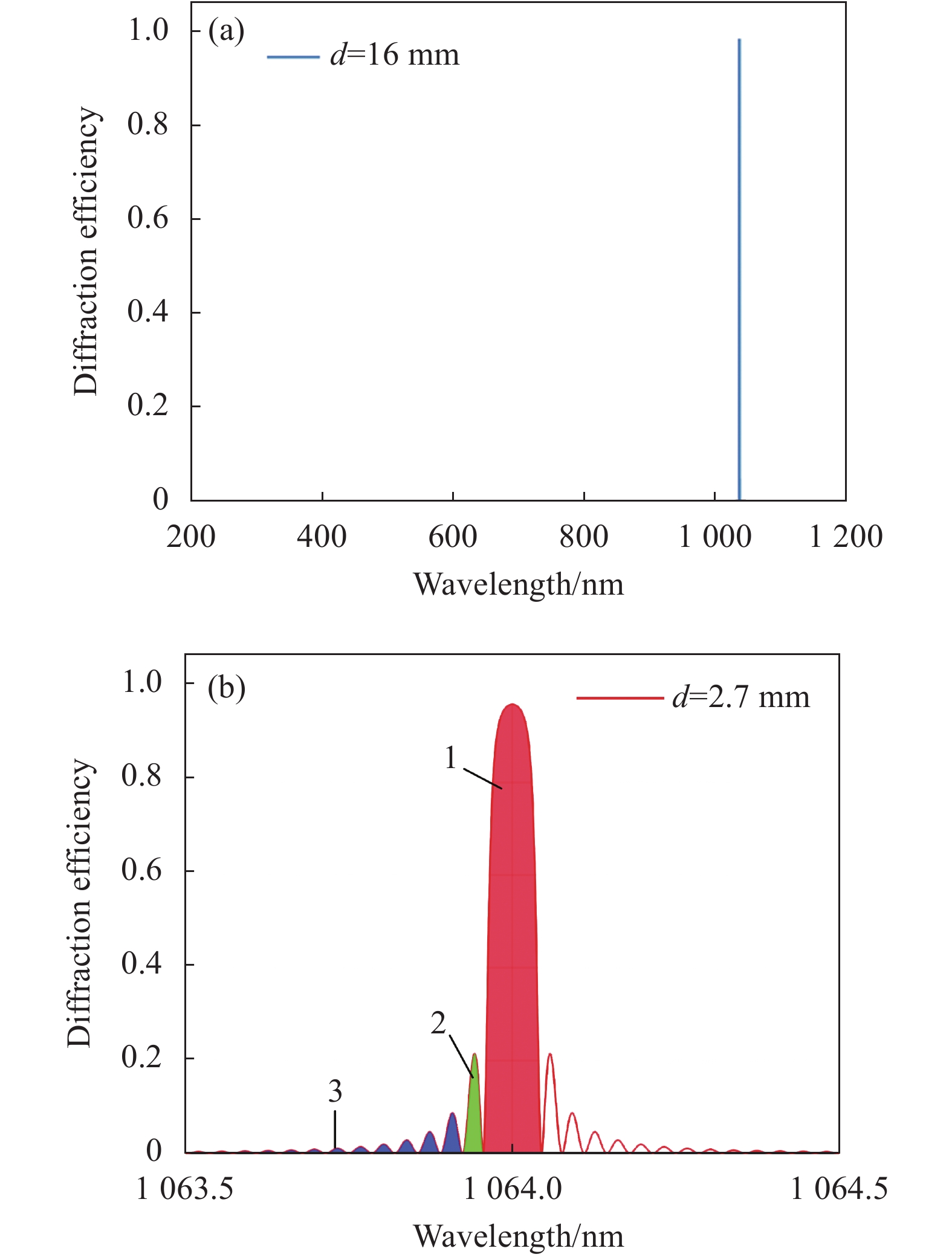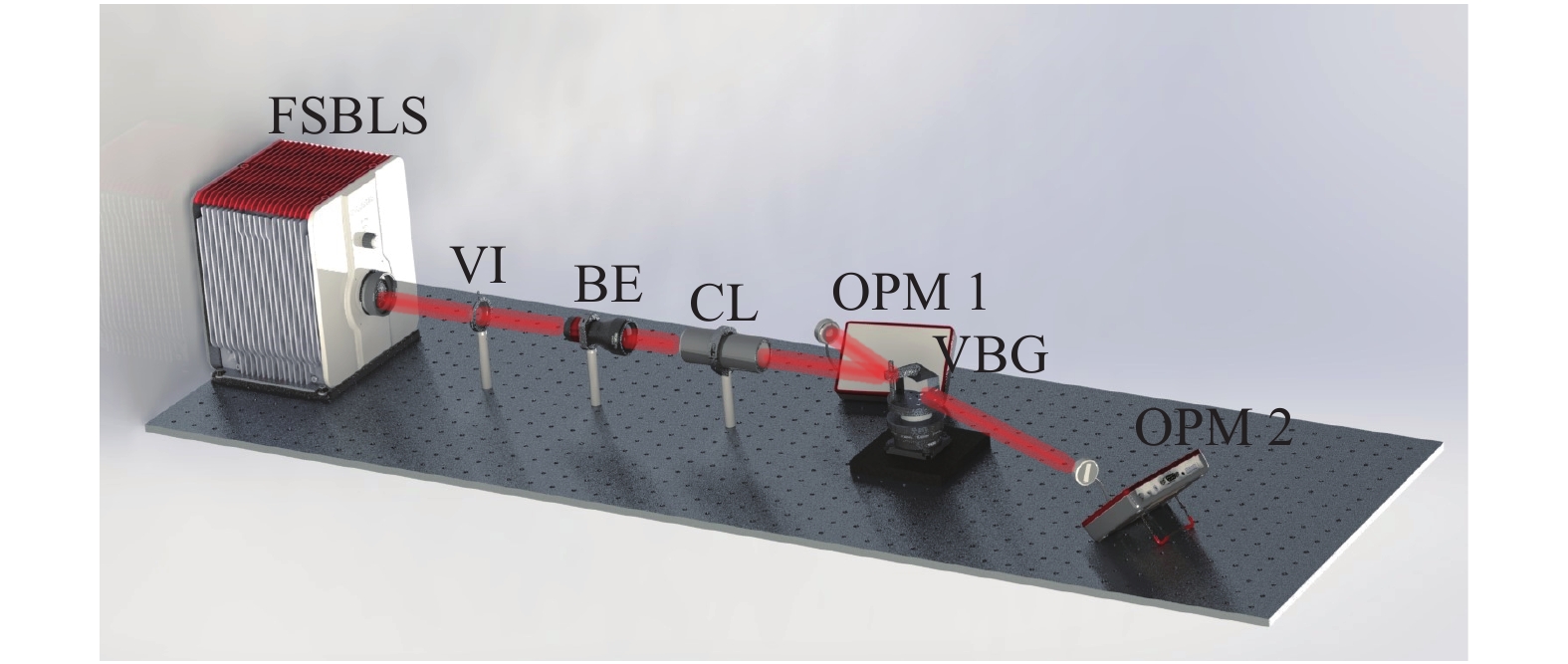HTML
-
作为一种新型的光栅,体布拉格光栅(Volume Bragg Grating, VBG)拥有良好的光学性能,具有极窄的光谱线宽以及良好的角度选择性[1-3]。目前被广泛地应用在窄线宽激光器生成、激光器模式选择、波长锁定、光束控制等领域[4-9]。1969年,Kogelnik阐述了耦合波理论[10],从理论上解释了体布拉格光栅的窄带滤波与衍射特性[11-13]。2003年,Glebov等人在美国中佛罗里达大学完成了基于光热敏折变玻璃材料(PTR)的体布拉格光栅的制备,最高衍射效率达到98%[14]。得益于PTR材料良好的物理特性,此种体光栅有较高的激光损伤阈值与热稳定性[15]。目前性能优异的体光栅衍射效率可达99.7%,光谱带宽低至20 pm,角度选择性1~100 mrad。根据不同的实际需要,体光栅应用范围可以从几百纳米扩大到几个微米。
研究了基于PTR材料的体布拉格光栅光谱滤波与角度特性。首先根据Kogelnik耦合波理论,依据边界条件,给出了反射式体布拉格光栅的衍射效率公式,根据后续系统需求,在中心波长为1029、1064 nm处理论分析了不同的光栅参数(光栅厚度、光栅周期、折射率调制度、光栅倾角)对于体光栅光谱带宽和衍射效率的影响,分析了体光栅的自由光谱范围、带外抑制和角度滤波特性。这将对体布拉格光栅的设计做出指导。最后,搭建测试光路实验验证了反射式体光栅的窄带滤波与角度选择特性。
-
图1给出了用于分析的反射式体光栅模型,其中R、S分别为入射光与衍射光振幅大小,表示为
$R({\textit{z}}){{\rm e}^{ - j}}^{\overrightarrow \rho \cdot \overrightarrow r }$ 与$S({\textit{z}}){{\rm e}^{ - j}}^{\overrightarrow \sigma \cdot \overrightarrow r }$ 。$\overrightarrow K $ 为光栅矢量,大小$K{\rm{ = }}\dfrac{{2\pi }}{\varLambda }$ ,$\varLambda $ 为光栅周期,并且满足$\overrightarrow \rho - \overrightarrow K = \overrightarrow \sigma $ ,其中$\overrightarrow \rho $ 和$\overrightarrow \sigma $ 分别为入射光与衍射光的光矢量。$\varphi $ 为光栅矢量倾角,d为光栅厚度。依据Kogelnik耦合波理论[10],对于理想的无吸收型体光栅,其耦合波方程为:
式中:
${c_R}$ 和${c_S}$ 为倾斜因子,$\;\beta = \dfrac{{2\pi {n_0}}}{\lambda }$ ,且有式中:
${n_o}$ 和${n_1}$ 分别为平均折射率与折射率调制度;${\alpha _o}$ 和${\alpha _1}$ 为平均吸收常数与吸收常数的空间调制度。在理想情况下,${n_0} \gg {n_1}$ 、${k_0}{n_0} \gg {\alpha _0}$ 、${k_0}{n_0} \gg {\alpha _1}$ ,${k_0}$ 为真空波数,${k_0} = \dfrac{{2\pi }}{{{\lambda _0}}}$ ,$\kappa $ 为耦合系数,耦合系数给出了衍射光与入射光的能量转换关系,若=0,则不存在耦合。
$\tau $ 为失配参数,如果失配参数过大,也将会破坏光栅中的耦合,大小由下式给出:对于反射式体光栅(
${c_S} < 0$ ),边界条件$R(0) = 1$ ,$S(d) = 0$ 。至此可以联立上式得到无吸收(${\alpha _1} = {\alpha _0} = $ $ 0$ )、非倾斜($\varphi = 0$ )的反射式体光栅衍射效率公式为:式中:
$\psi = {n_1}\pi d/\lambda \cos \theta $ ;$\xi = d\tau/2\cos \theta $ 。从公式(6)可以得到不同的参数以及入射角度$\theta $ 会影响体光栅的衍射效率,这体现了体光栅的光谱滤波能力与角度选择特性。且当入射光满足布拉格条件,
$\theta {\rm{ = }}0$ ,$\varphi {\rm{ = }}0$ 时,衍射效率能够达到最大,
${\theta _0}$ 为入射光在光栅中与Z轴的夹角。而当入射角度发生变化时,不满足布拉格条件,角度与波长失配,从而会导致体光栅衍射效率下降,与理论值发生偏移。
-
结合实际体光栅的参数,对中心波长在
$1\;029\;{\rm{nm}}$ 和$1\;064\;{\rm{nm}}$ 处的体光栅进行了数值仿真。主要分析了光栅厚度、光栅折射率调制度、光栅周期、光栅倾角等因素的变化对光栅带宽及衍射效率的影响,并且分析了体光栅的角度滤波特性。 -
中心波长
$\lambda = 1\;029\;{\rm{nm}}$ 的光束垂直入射($\theta = 0$ )到非倾斜式($\varphi = 0$ )体光栅,光栅参数为${n_0} = 1.486$ 、${n_1} = 0.5 \times {10^{ - 4}}$ 、$\varLambda = 347\;{\rm{nm}}$ 、$d = 16\;{\rm{mm}}$ 。对于中心波长$\lambda = 1\;064\;{\rm{nm}}$ 的体光栅,光栅参数${n_0} = 1.486$ 、${n_1} = $ $ 3 \times {10^{ - 4}}$ 、$\varLambda = 360\;{\rm{nm}}$ 、$d = 2.7\;{\rm{mm}}$ 。分析了不同光栅参数变化时光谱带宽。最后分析了倾斜式光栅($\varphi \ne 0$ )光栅倾角对于光谱滤波性能的影响。如图2(a)所示,1029 nm处的体光栅光谱带宽在20 pm (3 dB带宽)左右,光栅厚度变化对于体光栅反射光谱带宽影响不大,主要影响体光栅的衍射效率。光栅厚度越大,衍射效率越高,这是由于随着光栅厚度的增加,光线在体光栅内部的反射次数增加,从而增加了光栅的衍射效率。但是对于上述参数的体光栅而言,当厚度大于20 mm时,衍射效率几乎达到最大,带宽达到最窄。如图2(b)所示,1064 nm处的体光栅光谱带宽在60 pm左右,厚度的变化会影响衍射效率与光谱带宽,厚度越大,衍射效率越高,光谱带宽越窄。在厚度大于6 mm时,衍射效率几乎达到最大,光谱带宽达到最窄。
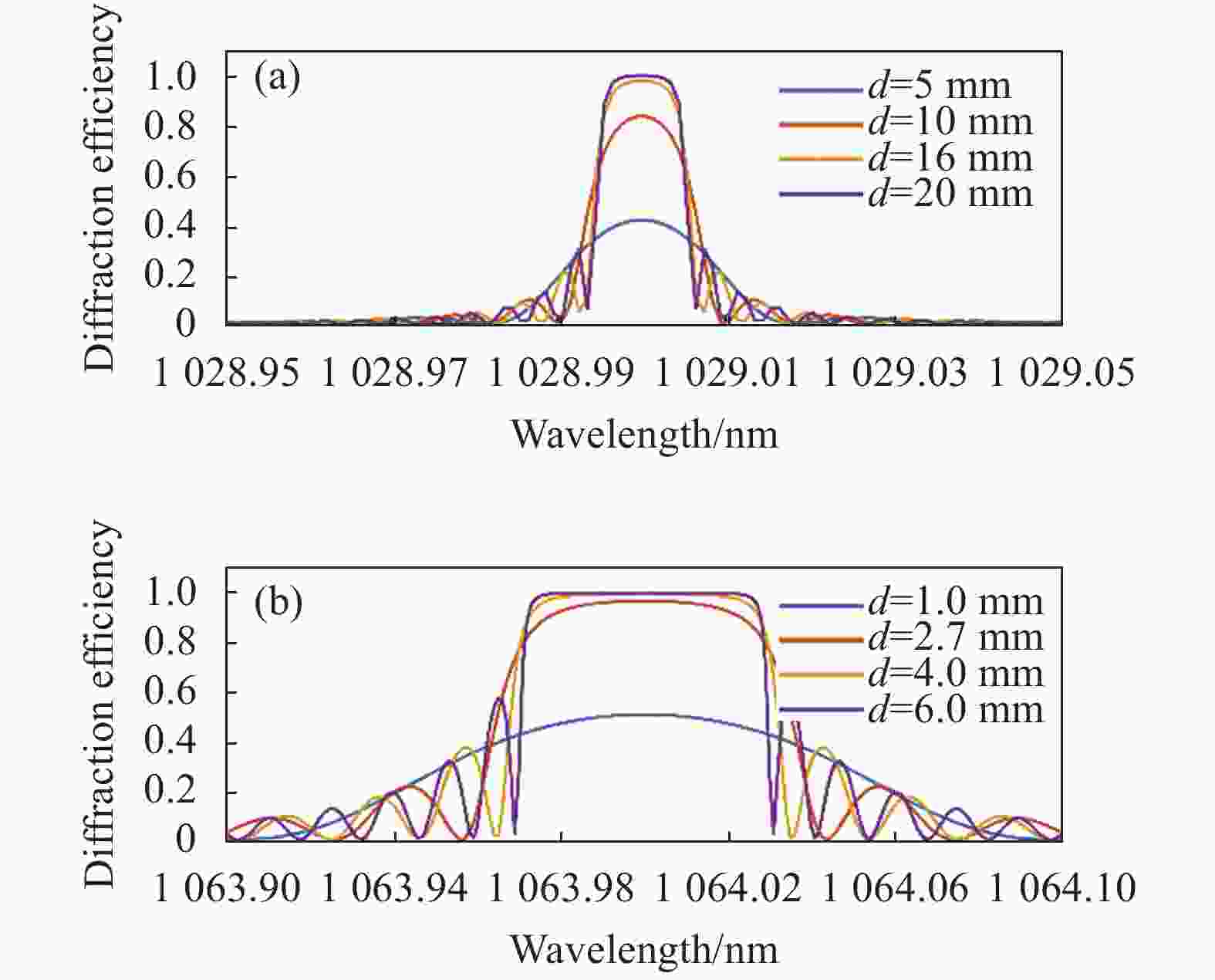
Figure 2. (a) Reflection spectra of VBG with different thicknesses at 1029 nm; (b) Reflection spectra of VBG with different thicknesses at 1064 nm
如图3(a)所示,1029 nm处,折射率调制度的变化对光谱带宽及衍射效率均有影响,随着折射率调制度的增加,衍射效率增加,但是光谱带宽也会随之增宽,影响体光栅光谱滤波性能。但是由于实际加工工艺所限,也会对折射率调制度的大小有所限制。如图3(b)所示,在1064 nm折射率调制度的变化对滤波性能的影响与1029 nm处类似,不再赘述。

Figure 3. (a) Reflection spectra of VBG with different refractive index modulation at 1029 nm; (b) Reflection spectra of VBG with different refractive index modulation at 1064 nm
如图4(a)所示,1029 nm与1064 nm处的光栅周期变化对光谱滤波性能的影响与折射率调制度对滤波性能的影响类似。光栅周期越大,衍射效率越高,但是光谱带宽也会变宽,当体光栅周期大于500 nm时,衍射效率达最大,理论上可达100%。

Figure 4. (a) Reflection spectra of different grating periods at 1029 nm; (b) Reflection spectra of different grating periods at 1064 nm
如图5所示,倾斜反射式体光栅的光栅倾角变化对于体光栅的光谱滤波性能几乎没有影响,各个倾角的反射光谱几乎重叠。由于实际需要,会将反射式体光栅与PTR玻璃端面形成一个夹角,用以减小反射光对于探测的影响,以提高体光栅光谱的滤波性能。
-
作为光谱滤波器件,自由光谱范围与带外抑制能力是衡量滤波性能的关键参数。体光栅拥有较宽的自由光谱范围与较强的带外抑制能力。在入射角以固定值入射时,体光栅的反射光谱仅有一个峰值出现,如图6(a)所示,在200~1200 nm的光谱范围内,体光栅仅仅只有一个反射峰。
图6(b)给出了1064 nm体光栅的带外抑制能力。区域1为峰值衍射的能量,区域2为第一旁瓣的能量,3为其余旁瓣能量。其中,区域1集中了整个光谱85%以上的能量,带宽80 pm左右。第一旁瓣在整个光谱能量占比小于4%,仅为峰值能量的5%。可以组合使用多块体光栅以减小旁瓣能量,理论上可以将旁瓣压低为0。在偏离中心波长0.2 nm外,能量小于1%。以上数据体现了体光栅较强的带外抑制能力,能够集中衍射中心波长附近的光线并有效抑制其余波长的光。光谱能量主要集中在峰值,能够有效地抑制旁瓣,并且可以通过组合体光栅压低旁瓣,因此不需要对体光栅进行切趾的操作。
-
体光栅除了拥有良好的窄带滤波特性,还同时具有角度选择性,即满足布拉格衍射条件,以布拉格衍射角入射时,体光栅的衍射效率最大。当偏离布拉格衍射角时,则会产生相位失配因子,衍射效率下降,此时衍射光的中心波长会发生偏移。因此,可以在允许的衍射效率范围内,依据角度滤波特性将体光栅作为一个可调谐滤波器件,通过改变光束入射角得到不同中心波长的衍射光,扩大体光栅的应用范围。
仿真所用的光栅参数与2.1节中相同,依据布拉格条件,通过分析不同入射角度下体光栅的反射光谱来得到其角度滤波特性,并且在下一部分通过实际光路测试进行验证。
如图7所示,随着光栅厚度的增加,两个波段处衍射效率不断增加,但是角度选择性会逐渐收窄到最小,分别为0.1、0.8 mrad。在后文中,会实验分析在大角度改变下衍射光中心波长的变化情况,以指导体光栅的实际应用。

Figure 7. (a) Angular filtering characteristics of VBG with different thicknesses at 1029 nm; (b) Angular filtering characteristics of VBG with different thicknesses at 1064 nm
需要注意,对于反射式体光栅,衍射光并不简单地符合耦合波理论的假设,而是与制备体光栅时参考光的写入有关,光栅矢量与Z轴夹角越大,越符合理论假设。
2.1. 光谱滤波特性
2.2. 自由光谱范围与带外抑制
2.3. 角度选择特性
-
为了验证分析体光栅实际的光谱滤波与角度特性,设计了两块实物体光栅,设计参数与理论仿真参数一致,搭建了测试光路如图8所示。
该测试系统由自由空间宽带光源(FSBLS)、可变光阑(VI)、扩束镜(BE)、准直透镜(CL)、体布拉格光栅(VBG)、光功率计(OPM 1、2)组成。由于光束的发散角会影响体光栅的峰值衍射效率,采用可变光阑、扩束镜、准直镜对光束进行准直以减小发散角的影响。
宽带光源发出宽光谱光束,经由可变光阑、扩束镜、准直透镜、入射到反射式体光栅的反射面上,反射面镀上增透膜,透过率大于99.9%,衍射光由光功率计OPM1接收,透射光由OPM2接收,通过两只功率计的比值,得到体光栅的实际衍射效率。
在测试体光栅的光谱带宽时,将OPM 1替换为日本YOKOGAWA公司生产的高分辨率光谱分析仪AQ6370D。可以通过光谱仪显示直接得到体光栅反射光谱图像,通过光谱仪的运算功能可以得到光谱带宽数值。
-
对中心波长λ=1029 nm和λ=1064 nm的两块体光栅分别进行了实验测试,将实验测试数据归一化处理再进行高斯拟合,得到测试曲线,并且与理论仿真曲线进行对比。光谱带宽测试结果如图9所示。

Figure 9. (a) Measurement of diffraction efficiency of VBG at 1029 nm; (b) Measurement of diffraction efficiency of VBG at 1064 nm
可以看出,两块体光栅的中心波长相较于理论值有一定的偏移,光谱带宽有一定的展宽。中心波长的偏移主要是因为实验所用转台精度有限,导致角度不能够和布拉格角完全匹配,光谱带宽的展宽主要是由入射光束的发散角造成,同时波长偏移也会对带宽造成影响。1029 nm体光栅峰值能量大于81%,1064 nm体光栅峰值能量大于80%,理论仿真结果符合较好。
测试结果在1029 nm处的中心波长实测为1029.06 nm,光谱带宽为52 pm,此时的衍射效率为91%。在1064 nm处的中心波长实测为1064.0905 nm,光谱带宽为107.5 pm,此时的衍射效率为92%。相较于传统的光学滤波器件(透过率70%,光谱带宽1 nm左右),体光栅衍射效率更高,光谱带宽更窄。
实验值与理论值的数据对比由表1给出。
Center wavelength/nm Measured wavelength/nm Diffraction efficiency theoretical
value/measured valueTheoretical value/measured
value of spectral bandwidth1029 1029.06 97%/91% 20 pm/52 pm 1064 1064.0905 96%/92% 80 pm/107 pm Table 1. Comparison of VBG measurement data
从实测数据可得,衍射效率和光谱带宽均与理论设计值(即前文中仿真结果)相差较小,实验光路设计合理。并且,当使用准直性与单色性更好的激光光源时,体光栅的衍射效率与光谱带宽将会进一步提升。说明该实验能够有效地测试体光栅的光谱滤波性能,也体现了体光栅在实际应用时拥有良好的光谱滤波性能。
-
对上述两块体光栅的角度特性进行了测试。实验根据布拉格衍射条件,测试了体光栅在较大角度变化时,布拉格角发生变化导致中心波长的改变。
实验光路如图7所示,通过角度转台记录体光栅入射角度,使用光谱仪得到不同角度入射时的衍射光中心波长。这种特性使得将体光栅应用于可调谐滤波器件成为可能。图10给出了测试的角度曲线,并且与理论曲线进行了对比。

Figure 10. (a) Angle characteristics of VBG with center wavelength at 1029 nm; (b) Angle characteristics of VBG with center wavelength at 1064 nm
从图中可以看出,1029 nm体光栅在−2°附近与理论值重合较好,1064 m体光栅角度特性测量值基本符合理论值。0°附近与理论值重合,随着角度的增加,自由空间光路的散射以及反射将会产生影响,相对于理论值有部分偏离。这是由于体光栅有最佳工作波长,随着角度增加,自由空间光路的散射以及反射导致布拉格衍射条件被破坏,从而影响体光栅最佳的工作性能。在允许的波长范围内,通过旋转体光栅以得到不同中心波长的窄带衍射光,该结果可以用来指导体光栅用于可调谐滤波相关领域。
对于反射式体光栅,不满足布拉格衍射条件的入射光会经由体光栅端面透射,从而大大减少反射光对于衍射光的干扰,可显著提高衍射光信号的信噪比。
通过实验分别测试了体光栅的衍射效率、光谱宽度、角度特性,并且与理论仿真的结果进行了对比,分析了实际与理论的误差来源及如何提高体光栅的滤波性能。
3.1. 衍射效率和光谱带宽测试
3.2. 角度特性测试
-
综上,通过对体光栅各个光栅参数的理论推导、数值仿真、实验测试,定量地给出了光栅参数对于体光栅衍射效率和光谱带宽的影响。从结果来看,为了提高体光栅的衍射效率,应该选择更大的厚度、折射率调制度、周期,但是随着这几个参数的增加,会导致光谱带宽的展宽,因此需要根据实际需要,在光栅参数的选择上做出综合考虑。这对于体光栅的设计给出了指导,为后续体光栅的实际应用提供了理论支持。
通过实验测试,结果显示体光栅的实际滤波性能和光谱带宽与理论仿真结果符合较好,即1029 nm处衍射效率达到90%,光谱带宽在50 pm附近,1064 nm处衍射效率达到90%,光谱带宽在100 pm左右。两块体光栅均有一定的角度滤波特性,能在一定波段的范围内,通过改变光束入射角来得到不同中心波长的衍射光。但需要注意的是,随着角度的增加,体光栅的性能将会下降。这为体光栅应用于可调谐滤波器件提供了理论支持。
该研究所得出的结果解释了体光栅良好的光谱滤波性能、较高的衍射效率、一定的角度滤波特性的原因,推动了前人对于体光栅仅停留在理论仿真的研究,搭建了体光栅测设光路,实验验证了体光栅的各项光学性能。从文中的各项数据可以看出,体光栅拥有良好的光学性能,这为体光栅后续的应用提供了诸多的可能。
在后续的研究工作中,将进一步分析体光栅温度稳定性、结构稳定性等其他特性以拓展体光栅的应用范围,推动新型滤波器件和技术的发展。



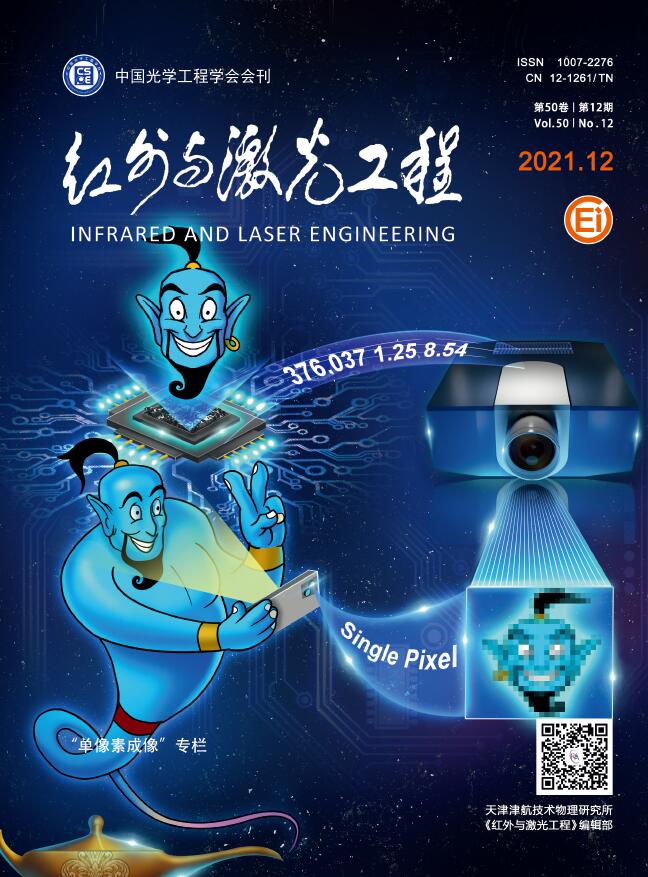


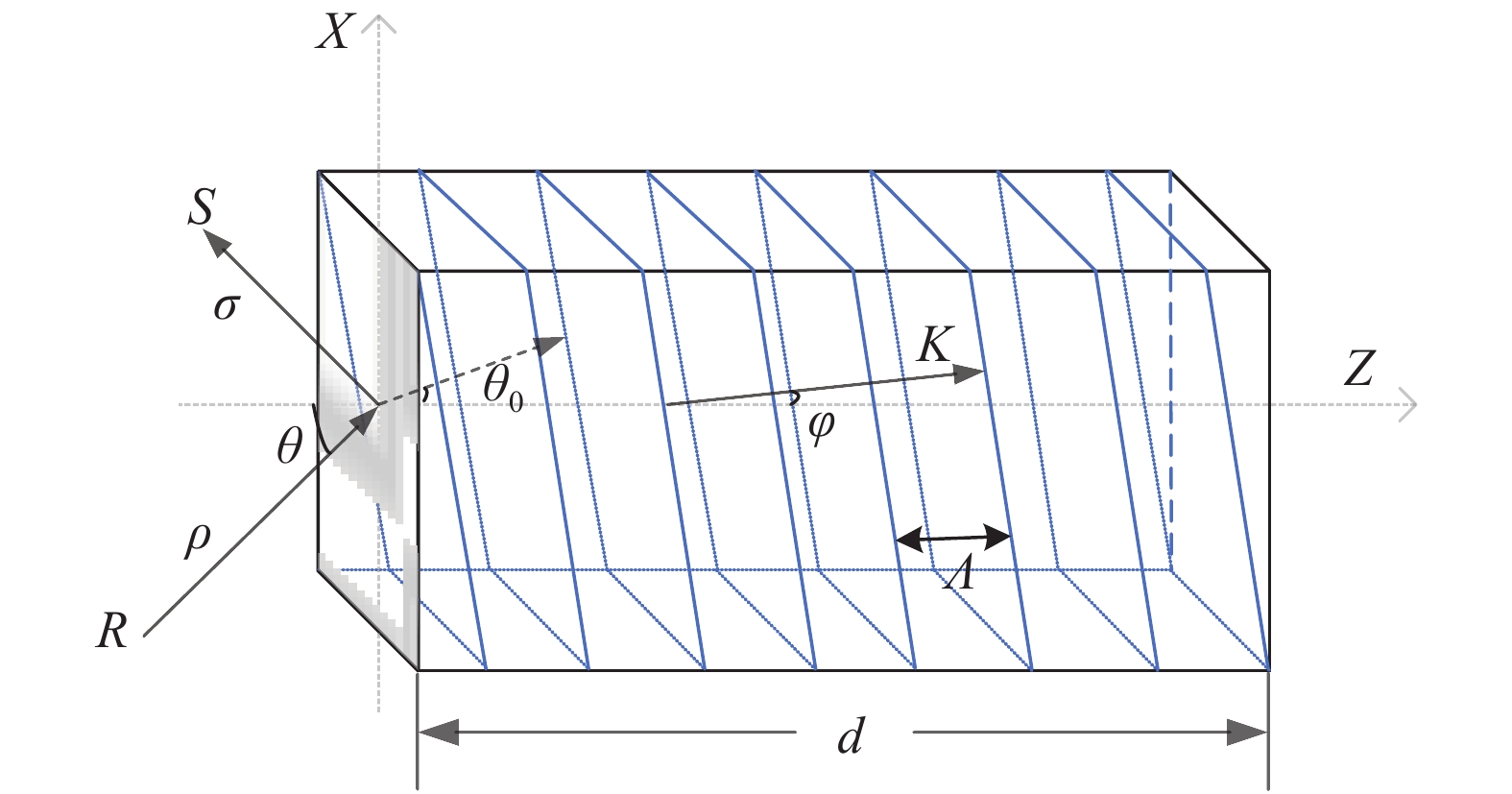











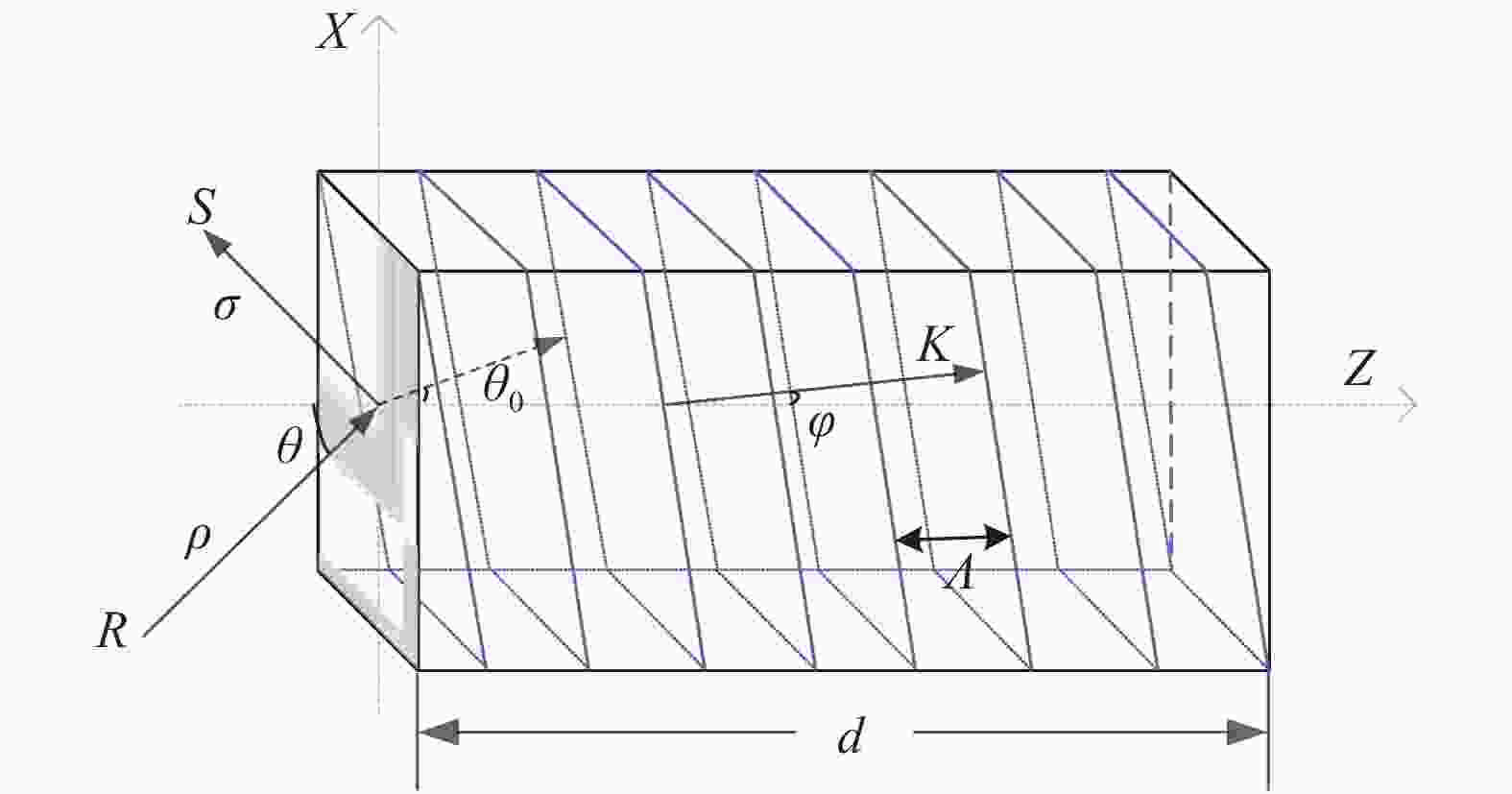










































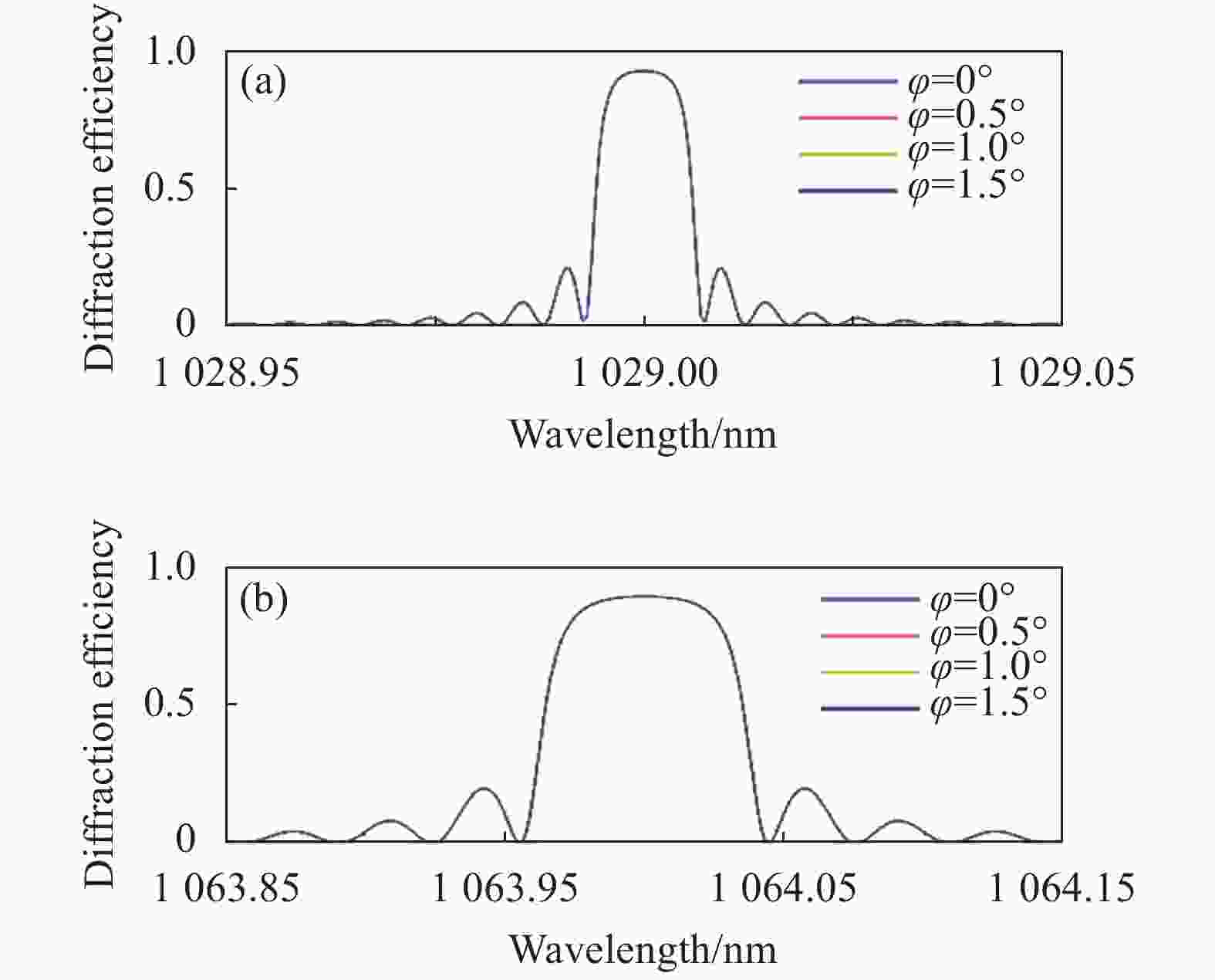
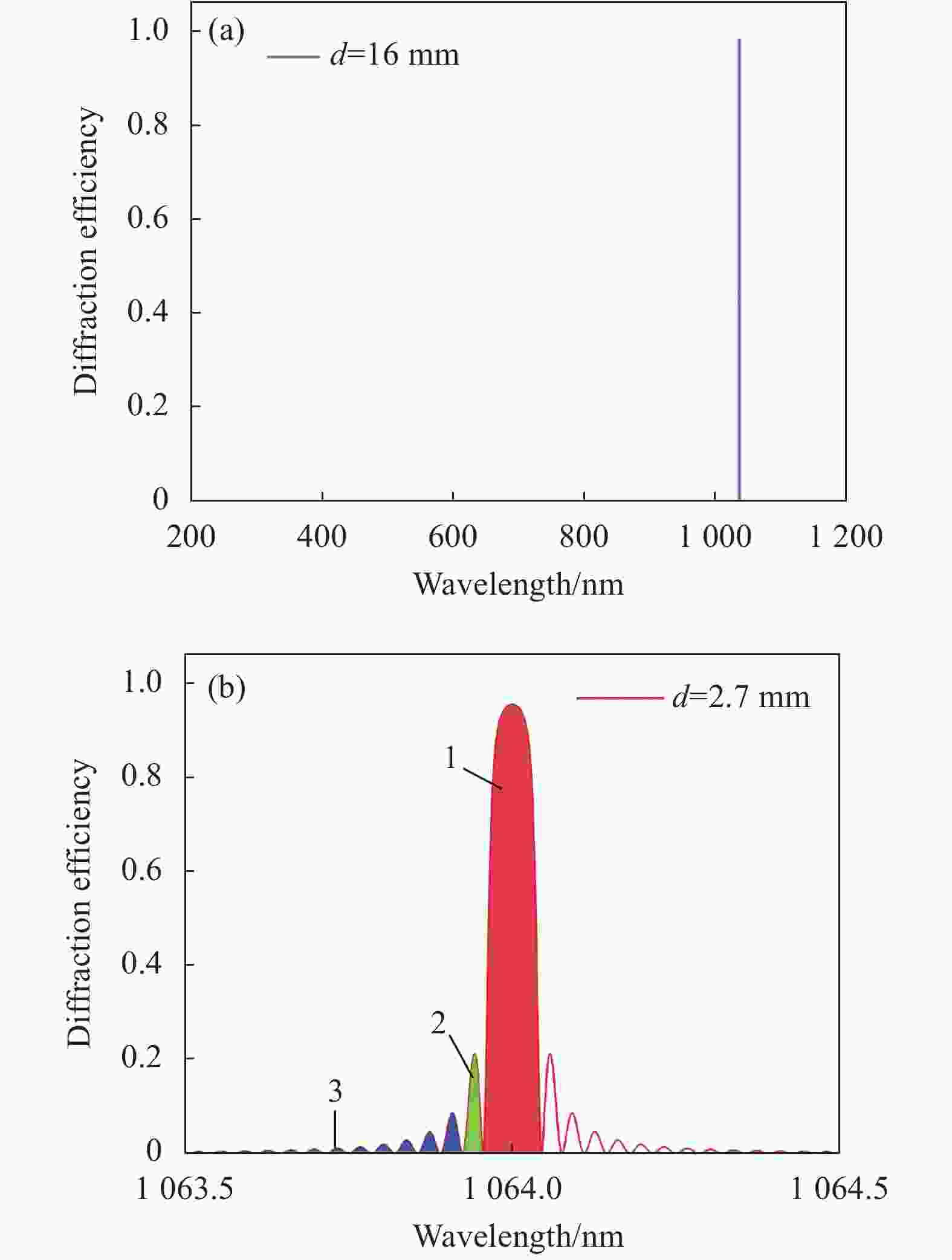


 DownLoad:
DownLoad:
